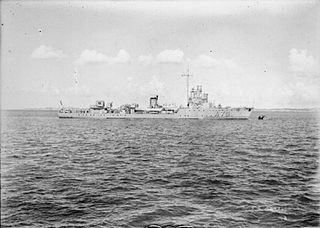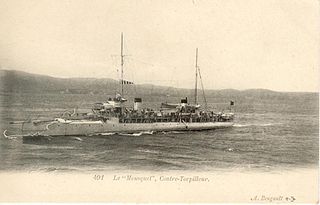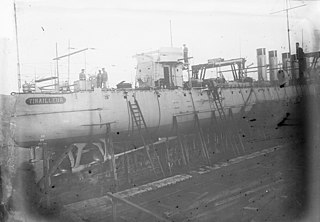Ships
The company built naval ships. Its products included the Ottoman Navy Lütf-ü Celil-class ironclads Lütf-ü Celil and Hifz-ur Rahman, the Japanese cruiser Unebi (1886) and Ottoman Samsun class destroyers Basra, Samsun, Taşoz and Yarhisar (all 1907). For the French Navy its ships included the First World War sloop Dédaigneuse (1916), Bougainville-class avisos Bougainville (1931) and Rigault de Genouilly (1932) and the La Galissonnière-class cruiser Gloire (1933).
In June 1939 the yard had launched another Bougainville class aviso, the Beautemps Beaupré. At the Fall of France she was still being completed at the yard so on 24 June 1940 the French took her out into the Gironde and scuttled her to prevent her from being captured. Another Bougainville class aviso, La Pérouse, was on order at the time but was cancelled.
On 11 November 1939 the French government ordered twelve Chamois-class avisos including three from Forges et Chantiers de la Gironde. After the Fall of France the company abandoned construction of two of these, La Rieuse and La Sérieuse, and suspended work on the third, which had been intended to be La Preneuse. Work on her resumed after 1945 and her intended name was changed to Commandant Ducuing in 1946. However, construction was finally abandoned in 1948.

Unebi (畝傍) was a protected cruiser built in France for the Imperial Japanese Navy (IJN) by Forges et Chantiers de la Gironde during the 1880s as the Japanese were not yet able to build warships of her size in Japan. Completed in 1886, the ship disappeared somewhere between Singapore and Japan on her delivery voyage with the loss of all hands.

The Bougainville class was a group of colonial avisos, or sloops, built for the French Navy during the 1930s. They were designed to operate in the remote locations of the French Empire.

The Voltigeur class was a pair of destroyers built for the French Navy in the first decade of the 20th century. Both ships survived the First World War and were scrapped afterwards.

Savorgnan de Brazza was one of eight Bougainville-class avisos built for the French Navy in the 1930s. Completed in 1933, she was assigned to the Far Eastern Naval Division where she cruised amongst the islands of French Polynesia and the coast of French Indochina. The ship returned to France following the beginning of World War II in 1939 and played a minor role in the Dunkirk evacuation in May–June 1940 after the Germans invaded France. Savorgnan de Brazza sailed to Britain to avoid capture later in June.

Rigault de Genouilly (PG-80) was a Bougainville-class aviso of the French Navy. She was designed to operate from French colonies in Africa, Asia, and the Pacific Ocean. During World War II, Rigault de Genouilly served on the side of the Allies until June 1940, and then in the naval forces of Vichy France. She was sunk in July 1940.

Dumont d'Urville was a Bougainville-class aviso of the French Navy, designed to operate from French colonies in Asia and Africa. She was built by Ateliers et Chantiers Maritime Sud-Ouest of Bordeaux and launched on 21 March 1931.

La Capricieuse was a ship of the French Elan-class minesweeping sloops. She was built by Chantiers Dubigeon at Nantes and launched on 19 April 1939.

The Élan class was a class of French minesweeping sloops. Originally designed as minesweepers, they were never used in that role, instead being used mostly as escort vessels. Built between 1936 and 1940, the first came into service just before the outbreak of World War II.
Commandant Dominé (U70/A15/F742) was a French Élan-class minesweeping sloop that served in World War II.

The Chamois class were French minesweeping sloops ordered between 1935 and 1939. They were similar in design to the Élan class, and like them classed as minesweepers, but were actually used as anti-submarine ships, convoy escorts and patrol vessels.

The Ateliers et Chantiers de France was a major shipyard that was established in Dunkirk, France, in 1898. The shipyard boomed in the period before World War I (1914–18), but struggled in the inter-war period. It was badly damaged during World War II (1939–45). In the first thirty years after the war the shipyard again experienced a boom and employed up to 3,000 workers making oil tankers, and then liquid natural gas tankers. Demand dropped off in the 1970s and 1980s. In 1972 the shipyard became Chantiers de France-Dunkerque, and in 1983 merged with others yards to become part of Chantiers du Nord et de la Mediterranee, or Normed. The shipyard closed in 1987.

Mousquet was an Arquebuse-class destroyer built for the French Navy in the first decade of the 20th century. Completed in 1903, the ship was initially assigned to the Mediterranean Squadron, but was transferred to the Far East the following year. She was sunk by the Imperial German Navy cruiser SMS Emden during the Battle of Penang in 1914, a few months after the beginning of World War I.

Fronde was a Arquebuse-class destroyer contre-torpilleur d'escadre built for the French Navy in the first decade of the 20th century. Completed in 1903, the ship was initially assigned to the Mediterranean Squadron, but was transferred to the Far East the following year. The ship was wrecked during a typhoon in 1906, but was salvaged and returned to service. She participated in the Battle of Penang in 1914, a few months after the beginning of the World War I. Fronde was transferred to the Mediterranean in 1915 and remained there for the war. The ship was sold for scrap in 1920.

Tirailleur was one of two Voltigeur-class destroyers built for the French Navy in the first decade of the 20th century.

Lütf-ü Celil was an ironclad warship of the Ottoman Navy, the lead ship of the Lütf-ü Celil class. Originally ordered by the Khedivate of Egypt, an autonomous vassal state of the Ottoman Empire, the central Ottoman government forced Egypt to surrender Lütf-ü Celil while she was still under construction at the French Forges et Chantiers de la Gironde shipyard. Lütf-ü Celil saw action during the Russo-Turkish War in 1877, where she operated on the Danube to try to prevent Russian forces from crossing the river. While on patrol on 11 May, she engaged a Russian artillery battery that scored a hit on the ship's boiler room, causing an explosion that destroyed the ship and killed most of her crew.

Hifz-ur Rahman was the second of two Lütf-ü Celil-class ironclads built for the Ottoman Navy in the late 1860s. Originally ordered by the Khedivate of Egypt, an autonomous vassal state of the Ottoman Empire, the central Ottoman government forced Egypt to surrender Hifz-ur Rahman while she was still under construction at the French Forges et Chantiers de la Gironde shipyard. The vessel was a turret ship, armed with two 229 mm (9 in) Armstrong guns and two 178 mm (7 in) Armstrong guns, both pairs in revolving gun turrets.

Asar-i Şevket was a central battery ship built for the Ottoman Navy in the 1860s. Originally ordered by the Eyalet of Egypt but confiscated by the Ottoman Empire while under construction, the vessel was initially named Kahira. The ship was laid down at the French Forges et Chantiers de la Gironde shipyard in 1867, was launched in 1868, and was commissioned into the Ottoman fleet in March 1870. Asar-i Şevket was armed with a battery of four 178 mm (7 in) Armstrong guns in a central casemate and one 229 mm (9 in) Armstrong gun in a revolving barbette.

Samsun was one of the four Durandal-class destroyers purchased by the Ottoman Empire from France in 1907. The ship served in the Ottoman navy during the Italo-Turkish War, the Balkan Wars and World War I.

Basra was one of the four Durandal-class destroyers purchased by the Ottoman Empire from France in 1907. The ship served in the Ottoman Navy during the Italo-Turkish War, the Balkan Wars and World War I.

Taşoz was one of the four Durandal-class destroyers purchased by the Ottoman Empire from France in 1907. The ship served in the Ottoman Navy during the Italo-Turkish War, the Balkan Wars and World War I.


















